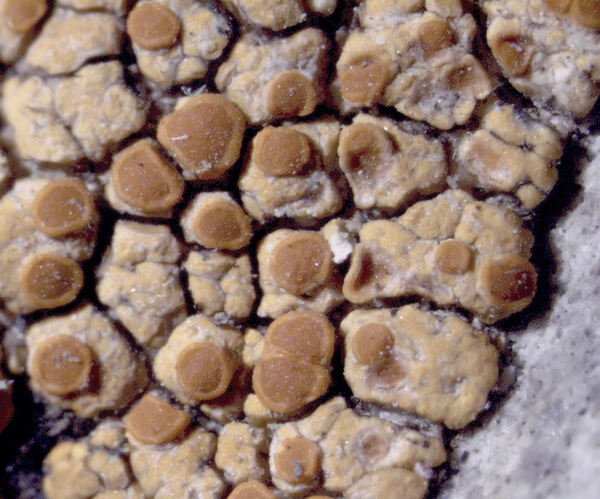Variospora dolomiticola (Hue) Arup, Søchting & Frödén
Nord. J. Bot., 31: 80, 2013. Basionym: Lecanora dolomiticola Hue - Ann. Mycol., 13: 83, 1915.
Synonyms: Caloplaca velana var. dolomiticola (Hue) Clauzade & Cl. Roux
Description: Thallus crustose, episubstratic, of angular, 0.4-1.2 mm wide, orange to yellow-orange areoles, rarely subcontinuous and finely cracked, usually well-delimited, sometimes with a black hypothallus, forming up to 3 cm wide patches. Cortex 25-95 μm thick, paraplectenchymatous, with yellowish orange crystals at the surface; medulla
paraplectenchymatous; algal layer discontinuous. Apothecia zeorine, frequent, usually angular by mutual compression, 0.2-0.8(-1) mm across, at first immersed in the areoles, then subsessile, with an initially flat, then sometimes convex, orange to brownish orange disc and a usually slightly paler, smooth, persistent margin. Thalline exciple well-developed, with many algae; proper exciple 85–100 μm wide, prosoplectenchymatous; epithecium orange, granular, K+ red; hymenium colourless, 50-90(-100) μm high; paraphyses sparingly branched in upper part, the apical cells swollen, up to 4-6 μm wide; hypothecium colourless, sometimes with oil droplets, prosoplectenchymatous. hyaline, very variable, Ascospores 2-celled, polarilocular, hyaline, ellipsoid to broadly ellipsoid, 9-13 x 5-10 μm, the equatorial thickening (“septum”) 3-5 μm (1/4-1/2 of spore length). Photobiont chlorococcoid. Spot tests: thallus and apothecia K+ red, C-, KC-, P-. Chemistry: thallus and apothecia with parietin (major), fallacinal, emodin, teloschistin and parietinic acid (minor), corresponding with chemosyndrome A of Søchting (1997).
Growth form: Crustose placodiomorph
Substrata: rocks
Photobiont: green algae other than Trentepohlia
Reproductive strategy: mainly sexual
Poorly known taxon in need of further study
Commonnes-rarity: (info)
Alpine belt: very rare
Subalpine belt: very rare
Montane belt: absent
Dry submediterranean belt: absent
Humid submediterranean belt: absent
Padanian area: absent
pH of the substrata:
1 2 3 4 5
Solar irradiation:
1 2 3 4 5
Aridity:
1 2 3 4 5
Eutrophication:
1 2 3 4 5
Poleotolerance:
0 1 2 3
Altitudinal distribution:
1 2 3 4 5 6
Rarity
absent
extremely rare
very rare
rare
rather rare
rather common
common
very common
extremely common
Loading data...
Occurrence data
Predictive map
Growth form: Crustose placodiomorph
Substrata: rocks
Photobiont: green algae other than Trentepohlia
Reproductive strategy: mainly sexual
Poorly known taxon in need of further study
Commonnes-rarity: (info)
Alpine belt: very rare
Subalpine belt: very rare
Montane belt: absent
Dry submediterranean belt: absent
Humid submediterranean belt: absent
Padanian area: absent
pH of the substrata:
| 1 | 2 | 3 | 4 | 5 |
Solar irradiation:
| 1 | 2 | 3 | 4 | 5 |
Aridity:
| 1 | 2 | 3 | 4 | 5 |
Eutrophication:
| 1 | 2 | 3 | 4 | 5 |
Poleotolerance:
| 0 | 1 | 2 | 3 |
Altitudinal distribution:
| 1 | 2 | 3 | 4 | 5 | 6 |
Rarity
absent
extremely rare
very rare
rare
rather rare
rather common
common
very common
extremely common
Loading data...
Occurrence data
Predictive map








